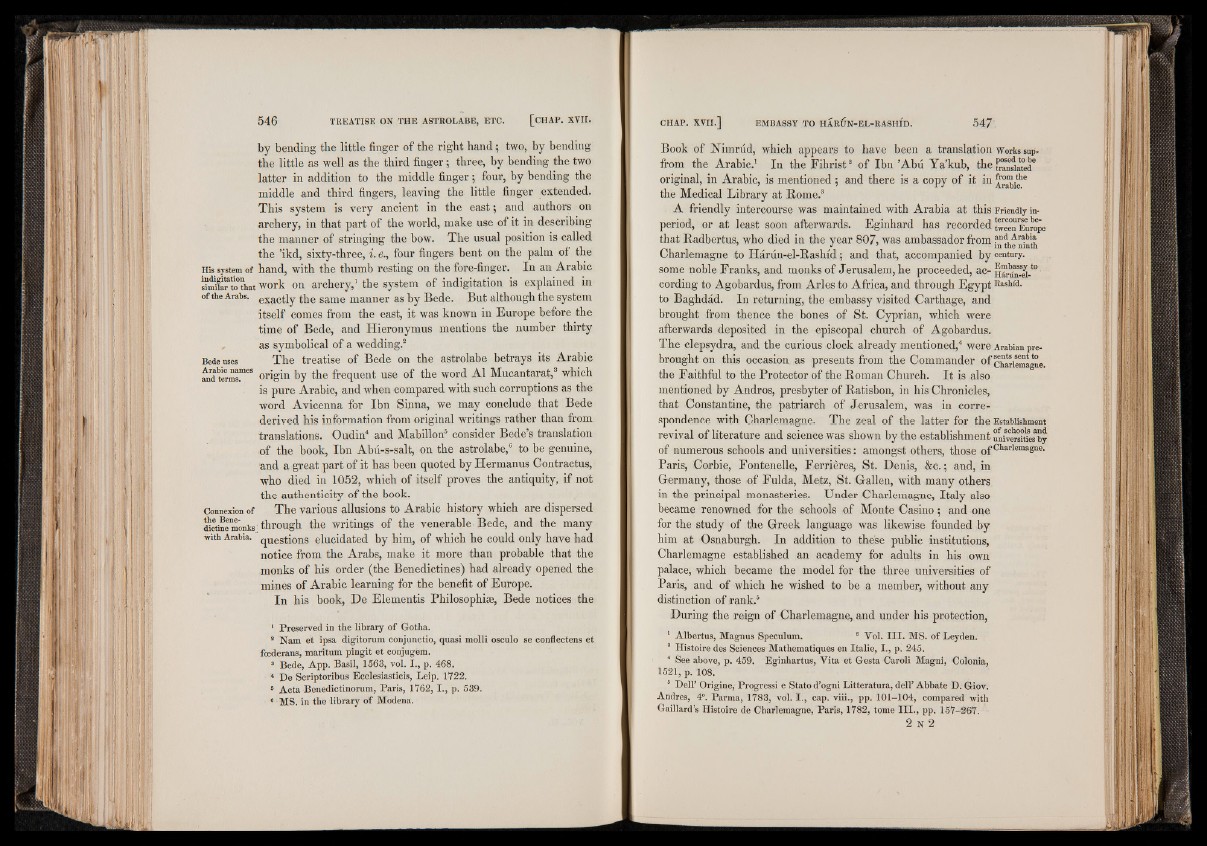
by bending the little finger of the right hand; two, by bending
the little as well as the third finger; three, by bending the two
latter in addition to the middle finger; four, by bending the
middle and third fingers, leaving the little finger extended.
This system is very ancient in the east; and authors on
archery, in that part of the world, make use of it in describing
the manner of stringing the bow. The usual position is called
the ’ikd, sixty-three, i. e., four fingers bent on the palm of the
His system of hand, with the thumb resting on the fore-finger. In an Arabic
sim^ar'to that work on archery,1 the system of indigitation is explained in
of the Arabs, exactly the same manner as by Bede. But although the system
itself comes from the east, it was known in Europe before the
time of Bede, and Hieronymus mentions the number thirty
as symbolical of a wedding.®
Bede uses The treatise of Bede on the astrolabe betrays its Arabic
Mdterms“65 origin by the frequent use of the word A1 Mucantarat,3 which
is pure Arabic, and when compared with such corruptions as the
word Avicenna for Ibn Sinna, we may conclude that Bede
derived his information from original writings rather than from
translations. Oudin4 and Mabillon5 consider Bede’s translation
of the book, Ibn Abu-s-salt, on the astrolabe,6 to be genuine,
and a great part of it has been quoted by Hermanus Contractus,
who died in 1052, which of itself proves the antiquity, if not
the authenticity of the book.
Connexion of The various allusions to Arabic history which are dispersed
Setine monks; through the writings of the venerable Bede, and the many
with Arabia. qUesti0ns elucidated by him, of which he could only have had
notice from the Arabs, make it more than probable that the
monks of his order (the Benedictines) had already opened the
mines of Arabic learning for the benefit of Europe.
In his book, De Elementis Philosophise, Bede notices the
1 Preserved in the library of Gotha.
8 Nam et ipsa digitorum conjunctio, quasi molli osculo se conflectens et
fcederans, maritum pingit et conjugem.
8 Bede, App. Basil, 1563, vol. I., p. 468.
4 De Scriptoribus Ecelesiasticis, Leip. 1722.
8 Acta Benedictinorum, Paris, 1762, I ., p. 539.
8 MS. in the library o f Modena.
Book of Nimrud, which appears to have been a translation Works sup-
from the Arabic.1 In the Fihrist2 of Ibn ’Abu Ya’kub, the fran^atecT
original, in Arabic, is mentioned ; and there is a copy of it in 2™^*®
the Medical Library at Rome.3
A friendly intercourse was maintained with Arabia at this Friendly in-
period, or at least soon afterwards. Eginhard has recorded Europe
that Radbertus, who died in the year 807, was ambassador from
Charlemagne to Harun-el-Rashid ; and that, accompanied by century,
some noble Franks, and monks of Jerusalem, he proceeded, ac- iSon-ei-10
cording to Agobardus, from Arles to Africa, and through Egypt Rashid,
to Baghdad. In returning, the embassy visited Carthage, and
brought from thence the bones of St. Cyprian, which were
afterwards deposited in the episcopal church of Agobardus.
The clepsydra, and the curious clock already mentioned,4 were Arabian prebrought
on this occasion as presents from the Commander of ctoiemagne.
the Faithful to the Protector of the Roman Church. It is also
mentioned by Andros, presbyter of Ratisbon, in his Chronicles,
that Constantine, the patriarch of Jerusalem, was in correspondence
with Charlemagne. The zeal of the latter for the Establishment
revival of literature and science was shown by the establishment unirarit^by
of numerous schools and universities: amongst others, those 0f Cbarlema£Iie'
Paris, Corbie, Fontenelle, Ferrieresj, St. Denis, &c. ; and, in
Germany, those of Fulda, Metz, St. Gallen, with many others
in the principal monasteries. Under Charlemagne, Italy also
became renowned for the schools of Monte Casino ; and one
for the study of the Greek language was likewise founded by
him at Osnaburgh. In addition to these public institutions,
Charlemagne established an academy for adults in his own
palace, which became the model for the three universities of
Paris, and of which he wished to be a member, without any
distinction of rank.5
During the reign of Charlemagne, and under his protection,
1 Albertus, Magnus Speculum. 8 Vol. I I I . MS. of Leyden.
8 Histoire des Sciences Mathématiques en Italie, I., p. 245.
4 See above, p. 459. Eginhartus, Vita et Gesta Caroli Magni, Colonia,
1521, p. 108.
8 Dell’ Origine, Progressi e Stato d’ogni Litteratura, dell’ Abbàte D. Giov.
Andres, 4“. Parma, 1783, vol. I ., cap. viii., pp. 101-104, compared with
Gaillard’s Histoire de Charlemagne, Paris, 1782, tome I I I . , pp. 157-267.
2 N 2